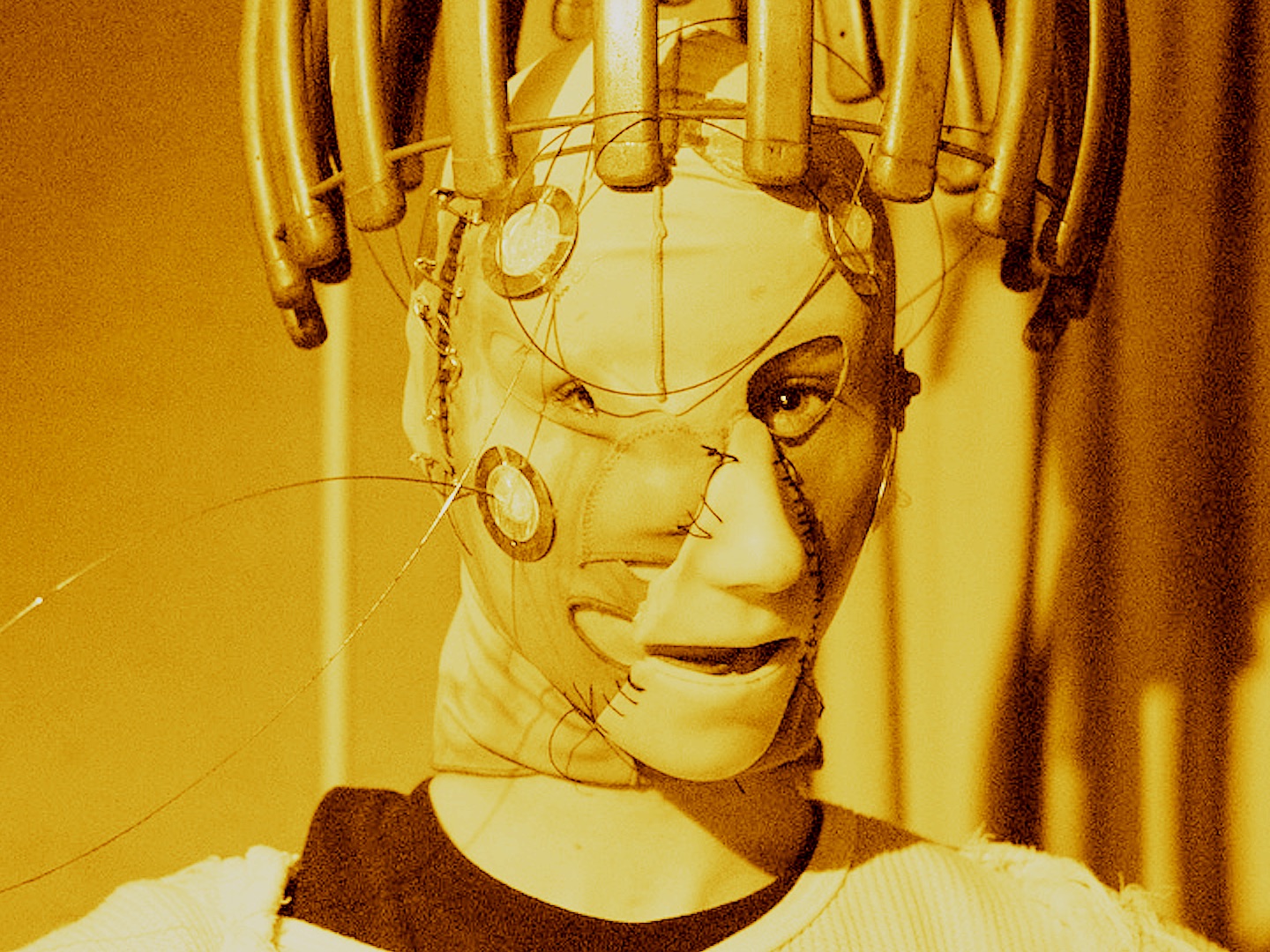
At the end of November Deaf Crocodile are poised to release what is easily their strangest offering to date – and given their back catalogue, that’s saying something. The release in question is a 4-disc set of Norbert Pfaffenbichler’s 2551 Trilogy, which marks the first time these films will be made available in America. Pfaffenbichler himself describes his films as “dystopian slapstick.” It’s a description that’s probably the closest anyone will ever get to coming up with an appropriate genre to pin on the trilogy.
At its surface the 2551 Trilogy follows a fairly simple narrative. Our protagonist saves a presumably orphaned child and takes him under his wing. When he’s later separated from the child, the protagonist embarks on a journey to reunite with him. The thing that makes this series of movies not-so-straightforward is that our protagonist happens to be an ape man who must navigate a post-apocalyptic subterranean police state populated with a wide variety of mutants, monsters, and madmen on his quest to find the Kid. Oh – and the films don’t use a single bit of dialogue. Rather, the entire story is told through the use of bizarre visuals and avant-garde filmmaking techniques.

The trilogy starts off with The Kid, which is heavily inspired by the Charlie Chaplin film of the same name. The opening scene drops viewers head-first into the world of 2551. Death metal blares and strobe lights flash during a clash between a violent police force and the mutant inhabitants. A stranded child with a burlap sack over his face stands in the midst of the chaos clutching a doll that looks like a mummified corpse. A stranger (the Ape Man) swoops in to save him, and irrevocably alters the trajectory of both of their lives. This first entry in the series does an incredible job of familiarizing the viewer with the deranged logic (or lack thereof?) that governs this world.
Orgies of the Damned is easily the most depraved of the trilogy, and has some of the most bizarre sexual content I’ve ever seen committed to film. This second entry in the series plunges the audience even further into the disturbing underworld of 2551 as the Ape Man staggers through a labyrinth of shady backrooms and sex dungeons on his quest to find the Kid, who was callously abducted in the previous film. Meanwhile, the Kid is forced by police to undergo rigorous training to become one of their latest recruits. Orgies of the Damned is filled with an endless variety of violent fetishes, latex bondage gear, unsanitary surgical suites, and a myriad of other perversions. It’s also the reason you have to verify your age before buying the boxset on the Deaf Crocodile website.
In the third and final installment, aptly titled The End, the Ape Man finally reunites with the Kid, who is now a grown man working as an inspector for the police. The End feels the most fully realized of the trilogy, and is the most out-there in terms of surreal content. This is especially true when the Ape Man eventually stumbles into an alternate dimension that transforms him in unexpected ways.

All three films are very much a vibe, albeit a nihilistic, disturbing, and deranged one. Much like films such as Eraserhead, Begotten, and Tetsuo: The Iron Man, the 2551 Trilogy is less concerned about the intricacies of its plot and is more focused on establishing a mood. This mood is thick throughout the series, and has multiple factors working together to help set it up.
First off is the setting – a dark, dank underworld filmed entirely in a series of abandoned World War 2 underground bunkers. Not one shot in any of the films takes place above ground.These bunkers make the perfect location to bring to life the depressing post-apocalyptic nightmare world the Ape Man and the Kid inhabit. It’s a cramped, brooding atmosphere filled with busted furniture, rusty surgical equipment, broken glass, and plenty of grime and grizzle to go around.
Just as vital as the scenery is the costuming. Every single character in each of the films wears some sort of mask, ranging from the lifelike mask the Ape Man wears to standard Mardi Gras-style masks. The fact that we can see none of the characters’ faces makes the films feel that much more otherworldly. To add to the surreality of the films it’s never made explicitly clear how literally we should be taking the masks. Are these all actual mutants wandering about? Or are they simply just broken humans hiding behind their masks? That’s up to the viewer to decide.
Finally, the mood is further cemented by a killer soundtrack that consists of several genres. We have death metal for the fight scenes and chase sequences; heavy and droning industrial music as the Ape Man ambles through the tunnels; and dark wave during some of the more somber moments. There are times where the focus on the music can become a bit overpowering. During these moments the films can start to feel like a long-form industrial music video lost in its own shocking imagery and stroboscopic effects. Still, they always eventually find a way to get back on track to the narrative, and for the vast majority of the films the marriage of music and visuals works great.
The influences Pfaffenbichler pulls from in this series are varied and pretty wild. There’s a heavy dose of Lynch in the aesthetic and dream logic of this world. There’s plenty of Charlie Chaplin physical humor, which serves as a relief from the otherwise relentlessly dark and disturbing subject matter. Throw in a dash of Brothers Quay and Jan Svankmeijer during the animated sequences as well. The color tinting and more fantastical sequences bring to mind the pioneering silent film work of Georges Méliès. The brutal police force in the series are reminiscent of the android police in George Lucas’s THX 1138. There are so many clear influences, and Pfaffenbichler sort of throws them all at the wall. Pfaffenbichler’s unique approach to mixing all of these influences results in a nightmarish collage that works surprisingly well.

I would be remiss if I didn’t discuss the performance of Stefan Erber, the actor who plays the Ape Man. He is somehow capable of bringing an intense emotional, human quality to the character despite having no dialogue and wearing a mask that obstructs his face during the entire runtime. He excels at conveying emotion through body language alone, much in the way silent film actors did back in the day. In the final portion of The End, after the Ape Man transforms into the Ape Woman, actress Manuela Deac matches Erber’s ability to convey emotion through limited means and brings additional complexity to the character.
While the bleakness of these films can, and often does, become overwhelming, there are brief moments of comedic relief that bring a fleeting sense of levity to the series. There are also moments of thoughtful meditation and hope. Once you settle in to the right mindset you can even find a bizarre sense of beauty and comfort amidst the mayhem. For instance, the Kid’s mummified corpse doll may seem unsettling when we’re first introduced to it, but throughout the course of the films it becomes a clear source of hope and inspiration for the Ape Man to press on in his journey to find the Kid.
By now it should be abundantly clear that the 2551 Trilogy is probably not going to click for mainstream audiences. Nor is it for the squeamish. But if you’re a more adventurous fan of transgressive cinema, abrasive music, and dystopian sci-fi, it’s definitely worth a viewing. There’s a little something for every type of weirdo to enjoy in this series, and plenty of moments to make even the most seasoned of cinephiles wonder what the hell they just witnessed (in a good way).




